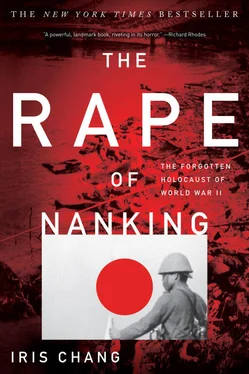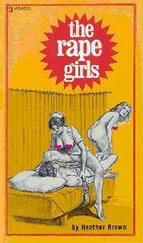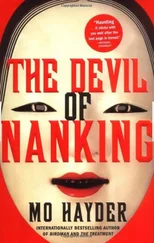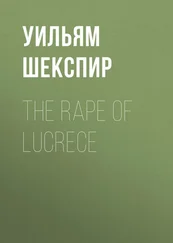Chinese women were raped in all locations and at all hours. An estimated one-third of all rapes occurred during the day. Survivors even remember soldiers prying open the legs of victims to rape them in broad daylight, in the middle of the street, and in front of crowds of witnesses. No place was too sacred for rape. The Japanese attacked women in nunneries, churches, and Bible training schools. Seventeen soldiers raped one woman in succession in a seminary compound. “Every day, twenty-four hours a day,” the Dagong Daily newspaper testified of the great Rape of Nanking, “there was not one hour when an innocent woman was not being dragged off somewhere by a Japanese soldier.”
Old age was no concern to the Japanese. Matrons, grandmothers, and great-grandmothers endured repeated sexual assaults. A Japanese soldier who raped a woman of sixty was ordered to “clean the penis by her mouth.” When a woman of sixty-two protested to soldiers that she was too old for sex, they “rammed a stick up her instead.” Many women in their eighties were raped to death, and at least one woman in that age group was shot and killed because she refused a Japanese soldier’s advances.
If the Japanese treatment of old women was terrible, their treatment of young children was unthinkable. Little girls were raped so brutally that some could not walk for weeks afterwards. Many required surgery; others died. Chinese witnesses saw Japanese rape girls under ten years of age in the streets and then slash them in half by sword. In some cases, the Japanese sliced open the vaginas of preteen girls in order to ravish them more effectively.
Even advanced stages of pregnancy did not render women immune to assault. The Japanese violated many who were about to go into labor, were in labor, or who had given birth only a few days earlier. One victim who was nine months pregnant when raped suffered not only stillbirth but a complete mental collapse. At least one pregnant woman was kicked to death. Still more gruesome was the treatment allotted to some of the unborn children of these women. After gang rape, Japanese soldiers sometimes slashed open the bellies of pregnant women and ripped out the fetuses for amusement.
The rape of women frequently accompanied the slaughter of entire families.
One of the most notorious stories of such a slaughter was recorded in detail by American and European missionaries in Nanking. On December 13, 1937, thirty Japanese soldiers came to the Chinese home at 5 Hsing Lu Kao in the southeastern part of Nanking. They killed the landlord when he opened the door, and then Mr. Hsia, a tenant who had fallen to his knees to beg them not to kill anyone else. When the landlord’s wife asked why they murdered her husband, they shot her dead. The Japanese then dragged Mrs. Hsia from under a table in the guest hall where she had tried to hide with her one-year-old baby. They stripped her, raped her, then bayoneted her in the chest when they were finished. The soldiers thrust a perfume bottle in her vagina and also killed the baby by bayonet. Then they went into the next room, where they found Mrs. Hsia’s parents and two teenage daughters. The grandmother, who tried to protect the girls from rape, was shot by revolver; the grandfather clasped the body of his wife and was killed immediately.
The soldiers then stripped the girls and took turns raping them: the sixteen-year-old by two or three men, the fourteen-year-old by three. The Japanese not only stabbed the older girl to death after raping her but rammed a bamboo cane into her vagina. The younger one was simply bayoneted and “spared the horrible treatment meted out to her sister and mother,” a foreigner later wrote of the scene. The soldiers also bayoneted another sister, aged eight, when she hid with her four-year-old sister under the blankets of a bed. The four-year-old remained under the blankets so long she nearly suffocated. She was to endure brain damage for the rest of her life from the lack of oxygen.
Before leaving, the soldiers murdered the landlord’s two children, aged four and two; they bayoneted the older child and split the head of the younger one with a sword. When it was safe to emerge, the eight-year-old survivor, who had been hiding under the blankets, crawled to the next room where she lay beside the body of her mother. Together with her four-year-old sister, they lived for fourteen days on rice crusts that their mother had prepared before the siege. When a member of the International Committee arrived at the house weeks after the slaughter, he saw that one young girl had been raped on the table. “While I was there,” he testified later, “the blood on the table [was] not all dry yet.”
A similar story, no less grisly, involves a fifteen-year-old Chinese girl whose family was murdered before her eyes. The Japanese first killed her brother, whom they wrongly accused of being a Chinese soldier, then her brother’s wife and her older sister because they both resisted rape, and finally her mother and father, who knelt on the floor begging the Japanese to spare the lives of their children. Before they died under the thrusts of Japanese bayonets, their last words urged the young girl to do whatever the enemy soldiers wanted from her.
The girl fainted. She revived to find herself naked on the floor in a strange, locked room. Someone had raped her while she had been unconscious. Her clothes had been taken from her, as they had been taken from other girls in the building. Her room was on the second floor of a building converted into barracks for two hundred Japanese soldiers. The women inside consisted of two groups: prostitutes, who were given their freedom and treated well, and respectable girls who had been kidnapped into sexual slavery. Of the latter group, at least one girl attempted suicide. For a month and a half the fifteen-year-old was raped two or three times a day. Eventually she became so diseased the Japanese left her alone. One day a kind Japanese officer who spoke Chinese approached her and asked why she was weeping. After hearing her story, he took her to Nanking by car, set her free inside the South Gate, and wrote down the name of Ginling College for her on a piece of paper. The girl was too sick to walk to Ginling the first day and took refuge in a Chinese house. Only on the second day did she reach Ginling, where International Committee members immediately rushed her to the hospital.
That girl was considered fortunate. Many other girls, tied naked to chairs, beds, or poles as permanent fixtures for rape, did not survive such treatment. Chinese witnesses described the body of an eleven-year-old girl who died after she was raped continuously for two days: “According to eyewitness reports, the blood-stained, swollen and ruptured area between the girl’s legs created a disgusting scene difficult for anyone to look at directly.”
During the mass rape the Japanese destroyed children and infants, often because they were in the way. Eyewitness reports describe children and babies suffocating from clothes stuffed in their mouths or bayoneted to death because they wept as their mothers were being raped. American and European observers of the Rape of Nanking recorded numerous entries like this one: “415. February 3, about 5 P.M. at Chang Su Hsiang (near Ta Chung Chiao) three soldiers came and forced a woman to throw away her baby and after raping her they went away laughing.”
Countless men died trying to protect their loved ones from rape. When the Japanese dragged away one woman from a mat shed and her husband intervened, they “stuck a wire through his nose and tied the other end of the wire to a tree just like one would tie up a bull.” There they bayoneted him repeatedly despite the pleas of his mother, who rolled around on the ground, crying hysterically. The Japanese ordered the mother to go into the house or they would kill her. The son died from the wounds on the spot.
Читать дальше











